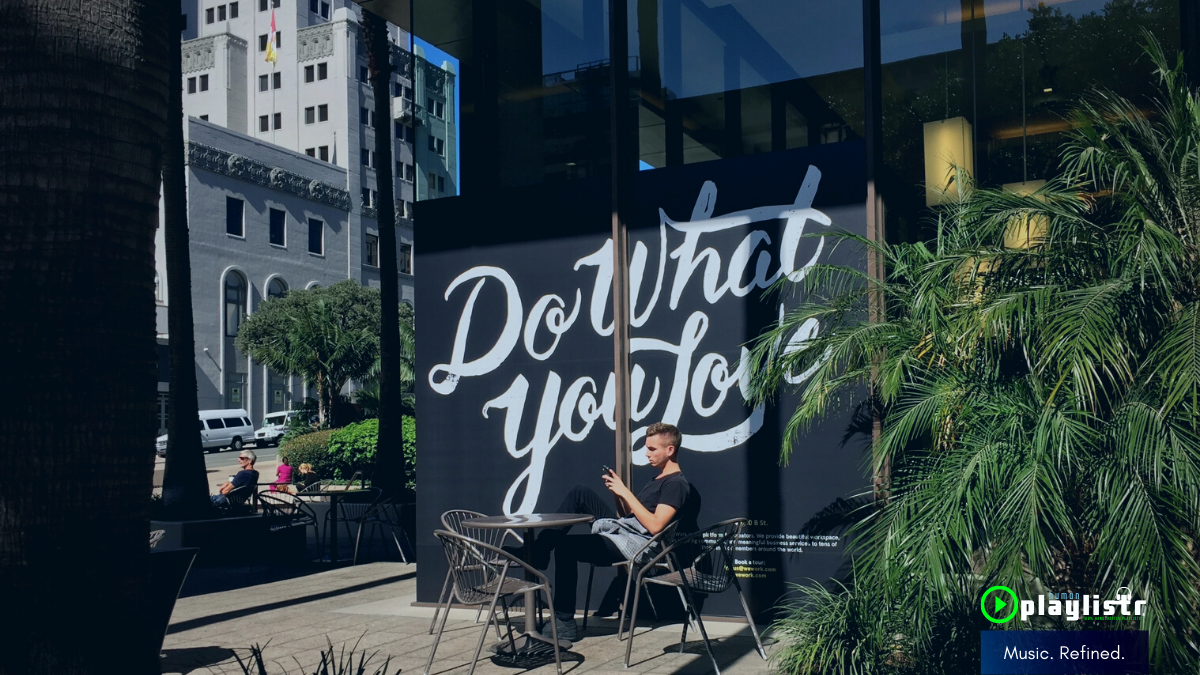100% handcrafted playlists. That’s my tagline, unique selling point and customer promise. It’s built into the DNA of the HumanPlaylistr name. When you ask me to make a playlist, I guarantee I will have listened to every track in full to ensure every track meets the requirements of the playlist.
In a previous post Attenuate what you don’t want, I gave a bit of insight into how I start a playlist by inputting far too many tracks from my own categorised library and then refining it into a seed of around 30 tracks that contain the distilled essence of the character I’m looking for.
I realise I might come across as slightly derogatory about the automated suggestions in Spotify, through the Discover Weekly feature, track and artist radio, and the suggestions at the bottom of each playlist. I’ll get to that in a minute; they’re impressive technologies.

Origins.
Let’s wind it back a step. How did I end up with my categorised library in the first place? Created over the last 10 years or so, some tracks are from CDs I owned in the 90s and heard in my formative years. Somewhere along the line, I’ve been introduced to this music, whether from relatives, friends or the radio. I’ve never underestimated the power of radio. Not everything will be to your liking but stands as a barometer of what’s popular. Radio stations live or die by their listener numbers.
So my wealth of tracks may feel entirely personal but undoubtedly contains unconscious bias, either through fond memories or keeping tracks based on significant periods in my life. I’ve expanded my library massively, filtered out the tracks I don’t like and, pushed through the further filter of customer requirements, my aim is to make the highest quality playlists I can.
You liked that, you might like this?
Imagine you’re ‘walking’ down a street in Google Street View. Perhaps you really like cottages and happen to be ambling through a UK village in the foothills of the Lake District.
Bear with me here.
Suppose an algorithm is taking note of what you’re looking at. After a certain amount of time it determines that you really like cottages in the countryside and takes ‘cottages’ and ‘countryside’ as two keywords as metadata for processing. The algorithm might even determine that you like double-storey cottages, with yellow cladding and large gardens.
When you next log in, the algorithm might recommend that you like Nordic Hanseatic cottages. Why not take a look at this particular village on the outskirts of Bergen? Beautiful cottages indeed, but not quite what you really like in your preferred style.
But how did you know you didn’t like Nordic cottages? Do you have a big book of cottages with a bookmark in the UK country cottages section? If you hadn’t seen a variety of other cottages, would you be able to compare and ascertain what it is about UK cottages you like? Perhaps there are some features that you do like and would like to see in UK cottages.
What if you decide to build a cottage in your favourite location in the UK, but you decide you’d like windows from Sweden, a roof from Switzerland, a door from Sri Lanka and a decked area from Australia? How will you know what works together, and how will you put it together? Can you build it yourself or do you need help?
Still with me? Have I used the word ‘cottage’ too much?
This is a round about way of asking, “Could artificial intelligence successfully put a cottage together, based on my previous viewings and predicted preferences?”
This is a very round about way of asking, “Could artificial intelligence quickly build automated and effective playlists based on previous listening, predicted future listening and some inherent qualities of both? Does artificial intelligence have a place in a business built on the premise of 100% handcrafted product?”
Searching for new music.
I have 4,000 tracks lined up, categorised neatly in my Spotify library. But if business takes off I’ll go through that really quickly and I’ll be back on the hunt for new tracks. I want you to have something individual to you as a customer. Bearing in mind each playlist seed is 30 tracks, refined over many weeks, you’d think Spotify or Soundtrack Your Brand would be ideal tools. These are technologies based on what you like. You can’t just put ‘music I like’ into a search engine.
For music discovery purposes, artificial intelligence is the art of mapping metadata, surfacing tracks that have been analysed and may be a match for a set of requirements thus making automated suggestions for playlists. Whatever platform is used, the principles are roughly the same. Tracks are analysed and tagged with metadata that contains information regarding basic information such as release date, length, bpm and top-level genre. The more intelligent the artificial intelligence engine, the deeper the level of data required, such as acousticness, energy, danceability, mood and more. Some tools I already use to simply organise my playlists can delve into Spotify’s method of classification via Echo Nest to display it to me; none of those tools are capable of analysis.
You can read more about Spotify’s Echo Nest here.
Both Spotify and Soundtrack Your Brand contain great discovery technologies, unimaginable a few years ago, much like Google Street View. The fact is they do bring tracks to my attention that I rigorously audition before selecting for library addition. They may ultimately make it onto a playlist if I think they’re the right fit. They cannot provide the volume of tracks I might need and for some reason I find the majority of recommendations fail to hit the mark with me.
New music (or at least, new to me) has to be found somewhere. My musician friends and contacts are great at signposting. I follow music news and keep up to date with Spotify Release Radar. But I don’t really have the time to follow up anything else. If I create a playlist myself I can get 50-100 tracks into a playlist given a few hours. How do I know that playlist seed does what I say it does? How will I find tracks to fill, potentially, a 40 hour playlist?
Artificial Intelligence vs. augmentation intelligence.
Let’s be ultra clear. I don’t want you as a customer to think I take 30 tracks, throw them into a tool, out comes 8 hours of music and I charge a premium for clicking ‘OK’.
However, it might be useful to have a digital assistant. I’m a sole trader and what I’m really selling is my taste in music. So if I audition a number of tracks that are suggested to me, they may augment my library but only if I truly believe the tracks have a place in my library. After all, my library is a staging area to the playlists so it has to have the qualities I look for – melody, harmonic fit, dynamic range fit, interest and whether I like it.
There’s a tool out there which I’m exploring, called Cyanite. I signed up for a free account, initially drawn in by the insights and visualisation tools. I know my playlists really well and have put them together based on my knowledge and how the tracks feel when run together. I have no evidence they do what I say they do. How do I get you, the customer, to listen to playlists and judge them as doing what I say they do?
I ran a few of my sample playlists through the tool and found the results pretty much as I expected, which in some ways was a relief. I always give due credit to the bravery of artists who make their creative output available to the public. I feel a responsibility to amplify and strengthen that output, not just resell it as a different package. The playlists should be cohesive, demonstrate value and understanding of customer requirements, enhance brand perception, improve venue vibe and reflect individual taste. In some ways, that’s my creative output, spotlighting artists in the best light possible, surrounded by similar creative talent.

What can Cyanite do for me? I saw immediately it can provide a radar chart on playlist characteristics, overlaid with metadata on a per track basis largely in the directions I expected. There is much, much more for me to explore when I can prioritise this.
The CEO of Cyanite, Markus Schwarzer, very politely reached out to me post-registration, intrigued by my business premise appearing diametrically opposed to the idea of artificial intelligence. Markus initiated the contact, describing themselves as “utter music heads.” A friendly exchange of emails ensued, with an interesting discussion and a change of direction in my thinking about such automated technologies, drawing my own conclusions.
Competitive advantage.
There is a very obvious advantage when searching vast catalogues by large businesses such as creative agencies and film studios.
During my exchange with Markus it dawned on me that it might bring enhanced speed to my searches; an upscaled grinding of the gears.
I’m an individual consultant, a really small business engendering personal relationships in the customer journey, something I’ve also written about in Consultant or Influencer? I’m naturally cautious of how this type of technology might be used in my business and how it may be perceived.
Artificial intelligence might be viewed as a technology that creates increased output. For me, I might be able to use it to increase input. In other words, the artificial intelligence engine serves as augmentation intelligence to broaden my input bandwidth, rather than create my output feed. In that way, the artificial intelligence could feed tracks to me post organic seeding for me to audition which is part of my usual process.
I pick up tracks from all sorts of places and perhaps this will provide another avenue for discovery. After all, I’ll still listen to my Spotify Discover Weekly playlist for interest.
I will never relinquish the 100% handcrafted tag. For now, insights and visualisation as evidential backup on my playlists is the natural fit for artificial intelligence, with track suggestions being auditioned through my extremely demanding ears. Only if they make it past audition will they make it into my library.
In answer to my earlier question, “Could artificial intelligence quickly build automated and effective playlists?”

“It’s a great effort, but it’s not quite right.”
I think it can be really effective and useful. I’ll use it. It does, however, inherently miss out on the final human audition. Is the chosen music any good?
I retain control of my music discovery journey and playlist creation to benefit you, my customer.












